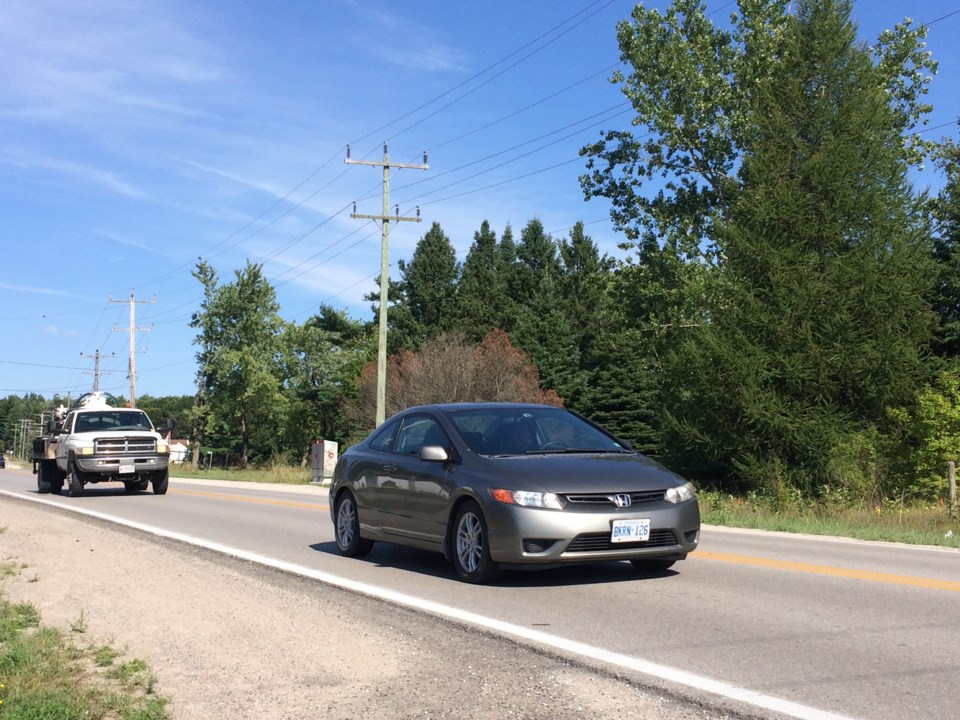Connecting links in Simcoe County like Sunnidale, Wilson and Shanty Bay roads aren’t made for cyclists, despite them being effective ways to get from A to B, the county says.
And until the county has the need to widen these roads – when perhaps it could add bike lanes – perhaps the county should restrict cyclists from using these roads.
From his home in the Grenfel area as he travels to Springwater’s Midhurst offices, Springwater Mayor Bill French sees cyclists venturing along Sunnidale Road and Wilson Road, roads which can be quite busy.
“I’m amazed at the number of people who ride their bikes there during busy times. There are many more cyclists on our roads,” said French, adding heavy trucks are also using those roads.
“We’re giving them a false sense of security, riding on roads with 80km (limits) and where cars are going 90 or 95 km/h,” he said.
The question of adding paved shoulders for cyclists came up this week, when a Ramara cyclist wrote a letter asking the county to begin planning to make its roadways safer for cyclists.
Konrad Brenner, a Ramara cyclist, pointed out County Road 169, which links Washago with Brechin, is a direct route that cyclists use. He has researched shoulder paving in other jurisdictions and advocated the county follow the example of municipalities like Niagara Region, which has created a long-term plan to pave all its roads’ shoulders.
“We have locally what amounts to a paved shoulder across the Narrows on Hwy. 12 (Ramara-Orillia boundary) and I am not aware of any cycle accidents on the bridge. This has existed for over 15 years,” Brenner said, as he urged the county to pave shoulders to make cycling safer.
Springwater’s French said there are two groups of cyclists – those who use their bicycles as transportation and those who ride for fun – and the county is serving just one of those groups.
“There are road cyclists and recreational cyclists and they’re different breeds,” said French, who noted those cyclists who use their bikes as transportation prefer to ride on paved roads because their tires are narrow. By contrast, the recreational cyclists ride bikes with fatter tires, which can better tolerate gravel, sand and off-road pathways.
The county has focused on the recreational ones.
“We’re putting trails in (throughout the county). We have a $250,000 budget, which we match with local municipalities to create bike paths,” said the county’s director of planning, development and tourism David Parks.
These bike trails are often more scenic, aimed at giving residents and tourists an enjoyable cycling experience. They may loop, rather than going directly from one point of interest to another.
But often, county roads – which connect communities and residents with workplace destinations – don’t have the space or proper grade to allow bike lanes to be added, said the county’s engineering and environment general manager Debbie Korolnek.
“It depends on the grade. This is a very, very busy route and we really don’t want to encourage bikes on this road,” she said of County Road 169. “There are alternate routes, but they do take you pretty far out of the area.”
Barrie struggled with the question of adding bike lanes to a major arterial several years ago. Cyclists urged the city to include bike lanes as the plans for the widening of Essa Road were being drawn up. The city, however, opted not to include the lanes, as the city preferred to see cyclists take a more round-about route from the southwest to the lakeshore and city core.
Barrie, however, has added paved shoulders and bike lanes to some linking roads in the city in a bid to calm traffic; examples include Ardagh Road and Hurst Drive.
French credited the city for creating bike lanes on those roads, which enable residents to ride their bikes to work and school.
“We don’t have a lot of four-lane roads in the county and couldn’t make that modification.
“When you’re going 50, you could stop. At 80 or 90, I question whether you’ll have the ability to stop.
“Until we can put in policies to put in cycling lanes on our roads, perhaps we have to prohibit cycling on some of these main roads,” said French.



